Arctic simulation of moon-like habitat shows well-being sessions can improve mental health in extreme isolation
Tuesday, 05 April 2022 13:51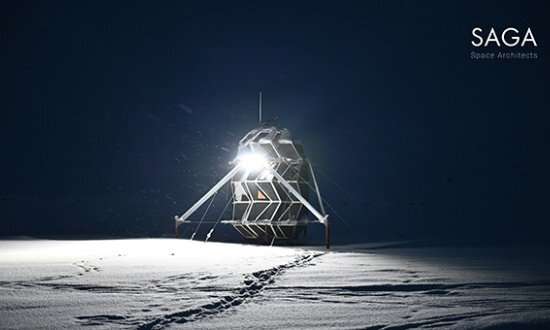
Researchers at the University of Surrey and the University of Milano-Bicocca have partnered with SAGA Space Architects to investigate the psychological impact of social isolation in harsh environments, such as on the moon. This research formed part of the LUNARK project which explored how humans could survive on the moon and have successful habitats there in the future.
The LUNARK project was the first ever Arctic simulation of a lunar mission. As part of the project, two space architects, Sebastian Aristotelis and Karl-Johan Sørensen, designed an airtight, portable, foldable pod that enables its occupants to live self-sufficiently. From September 2020, the architects lived inside the pod for 61 days in northern Greenland—a place that reflects the harsh environment of the moon and its freezing temperatures. The pod was built to withstand external threats—which was tested in the arctic simulation in the form of a visit from a local polar bear—and was designed to leave no trace of waste in the environment.
To investigate the impact of social isolation on the men, the researchers measured their perceptions of time, their positive and negative emotions, levels of satisfaction of basic psychological needs (e.g.
Orbital Reef passes design review
Tuesday, 05 April 2022 13:00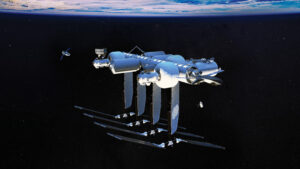
Orbital Reef, a commercial space station being developed by a consortium of companies, has completed an initial design review as part of a NASA award.
The post Orbital Reef passes design review appeared first on SpaceNews.
Ax-1: Why the private mission to the International Space Station is a game changer
Tuesday, 05 April 2022 12:17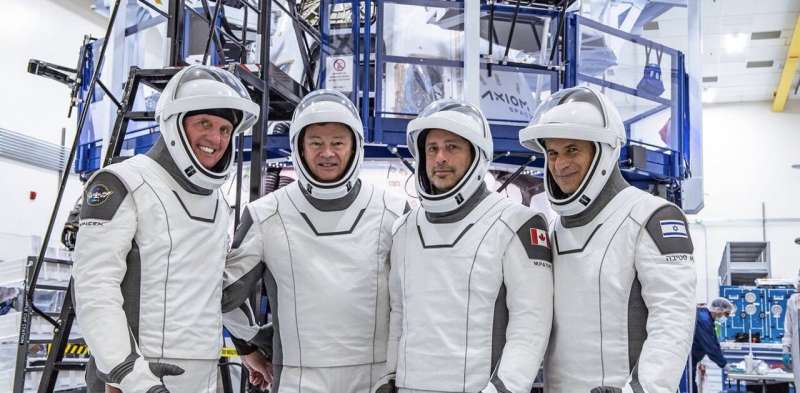
It's not long since billionaires were competing to get to the "edge of space." Now, the first set of private citizens are getting ready to take a SpaceX shuttle up to the International Space Station (ISS). Unlike the short "joyrides" of Richard Branson and Jeff Bezos, this mission will be reaching the roughly 400km altitude needed to dock with the ISS.
The mission by the US commercial aerospace company Axiom Space is a major step forward in private space travel, and is part of a plan to build a private space station.
Japan’s ArkEdge Space closes $18.7 million Series A for nanosatellite projects
Tuesday, 05 April 2022 12:00
Japanese startup ArkEdge Space has raised $18.7 million since this year to continue developing nanosatellite technologies needed for building an Earth-to-moon communication system and a multi-functional smallsat constellation.
The post Japan’s ArkEdge Space closes $18.7 million Series A for nanosatellite projects appeared first on SpaceNews.
York Space to triple satellite production to meet military and commercial demand
Tuesday, 05 April 2022 12:00
COLORADO SPRINGS – Air Force Secretary Frank Kendall, Space Development Agency Director Derek Tournear and other defense officials on April 4 toured the manufacturing facilities of Denver-based York Space Systems, one of three companies selected to build satellites for the Defense Department’s internet-in-space constellation.
Amazon signs on launch partners for space internet
Tuesday, 05 April 2022 11:59 Amazon on Tuesday announced deals for scores of launches to deploy a "constellation" of satellites in low orbit around the Earth to provide internet service to people below.
Amazon said that its contracts with Arianespace, Blue Origin and United Launch Alliance (ULA) are the largest commercial procurement of launch vehicles in history.
The overall cost and timing of launches booked to ma
Amazon on Tuesday announced deals for scores of launches to deploy a "constellation" of satellites in low orbit around the Earth to provide internet service to people below.
Amazon said that its contracts with Arianespace, Blue Origin and United Launch Alliance (ULA) are the largest commercial procurement of launch vehicles in history.
The overall cost and timing of launches booked to ma Amazon signs multibillion-dollar Project Kuiper launch contracts
Tuesday, 05 April 2022 10:00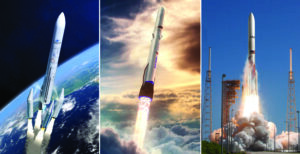
In the largest commercial launch deal ever, Amazon is purchasing up to 83 launches from Arianespace, Blue Origin and United Launch Alliance to deploy most of its 3,236-satellite Project Kuiper broadband megaconstellation
Juice minisite
Tuesday, 05 April 2022 07:12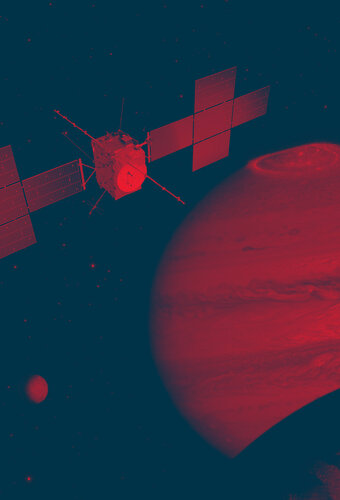
Juice: Jupiter Icy Moons Explorer
Juice: Jupiter Icy Moons Explorer
HENSOLDT Cyber and Beyond Gravity team up for robust satellite cybersecurity
Tuesday, 05 April 2022 07:03 HENSOLDT Cyber will supply its high security IT operating system TRENTOS to Beyond Gravity's for its latest satellite computer . The company's say this will ensure a high level of IT security for satellites is at the heart of today's efforts to make satellites more robust and reliable.
"As satellites have become increasingly critical to the infrastructure of modern society, there is an inc
HENSOLDT Cyber will supply its high security IT operating system TRENTOS to Beyond Gravity's for its latest satellite computer . The company's say this will ensure a high level of IT security for satellites is at the heart of today's efforts to make satellites more robust and reliable.
"As satellites have become increasingly critical to the infrastructure of modern society, there is an inc German satellite EnMAP launches successfully
Tuesday, 05 April 2022 07:03 It all began in 2003 with a competition announced by the German Space Agency at the German Aerospace Center as part of the National Space Programme. The task was to design and build a new type of hyperspectral instrument and a satellite to carry it, and to test both the instrument and its satellite for several years in the harsh conditions of space.
At the same time, an (inter)national com
It all began in 2003 with a competition announced by the German Space Agency at the German Aerospace Center as part of the National Space Programme. The task was to design and build a new type of hyperspectral instrument and a satellite to carry it, and to test both the instrument and its satellite for several years in the harsh conditions of space.
At the same time, an (inter)national com SpiderOak and Lockheed Martin Space enter space cybersecurity + blockchain collaboration
Tuesday, 05 April 2022 07:03 SpiderOak Mission Systems and Lockheed Martin (NYSE: LMT) Space's Mission Solutions business are developing and testing a zero-trust cybersecurity platform to secure data across the space data supply chain. The two companies have signed an agreement to field key components of the SpiderOak OrbitSecure platform. OrbitSecure allows national security and civil space agencies to harness the commerci
SpiderOak Mission Systems and Lockheed Martin (NYSE: LMT) Space's Mission Solutions business are developing and testing a zero-trust cybersecurity platform to secure data across the space data supply chain. The two companies have signed an agreement to field key components of the SpiderOak OrbitSecure platform. OrbitSecure allows national security and civil space agencies to harness the commerci Slingshot Aerospace wins US Space Force contract
Tuesday, 05 April 2022 07:03 Slingshot Aerospace, Inc., a company building world-class space simulation and analytics products to accelerate space sustainability, has been awarded a $25.2 million, 39-month contract from the U.S. Space Force's (USSF) Space Systems Command with strategic support from SpaceWERX.
The contract will facilitate delivery of two key Slingshot Aerospace products: the company's Digital Space Twi
Slingshot Aerospace, Inc., a company building world-class space simulation and analytics products to accelerate space sustainability, has been awarded a $25.2 million, 39-month contract from the U.S. Space Force's (USSF) Space Systems Command with strategic support from SpaceWERX.
The contract will facilitate delivery of two key Slingshot Aerospace products: the company's Digital Space Twi New technical concept for NATO's Future Surveillance and Control capabilities
Tuesday, 05 April 2022 07:03 Airbus Defence and Space together with Northrop Grumman and seven industrial players forming the ASPAARO (Atlantic Strategic Partnership for Advanced All-domain Resilient Operations) team have been selected by the NATO Support and Procurement Agency (NSPA) to conduct one of three Risk Reduction and Feasibility Studies (RRFS). The studies aim to suggest technical solutions for the Alliance Future
Airbus Defence and Space together with Northrop Grumman and seven industrial players forming the ASPAARO (Atlantic Strategic Partnership for Advanced All-domain Resilient Operations) team have been selected by the NATO Support and Procurement Agency (NSPA) to conduct one of three Risk Reduction and Feasibility Studies (RRFS). The studies aim to suggest technical solutions for the Alliance Future Axiom-1 targets Friday for ISS launch after NASA delays moon rocket test
Tuesday, 05 April 2022 03:07 Axiom Space announced it would delay its first private astronaut mission to the International Space Station to no earlier than Friday, April 8.
If all goes as planned, a previously-flown Falcon 9 rocket will ferry four private citizens, strapped inside a SpaceX Crew Dragon capsule, to the space station. Liftoff is scheduled for 11:17 a.m. EDT.
The mission was scheduled for Wednes
Axiom Space announced it would delay its first private astronaut mission to the International Space Station to no earlier than Friday, April 8.
If all goes as planned, a previously-flown Falcon 9 rocket will ferry four private citizens, strapped inside a SpaceX Crew Dragon capsule, to the space station. Liftoff is scheduled for 11:17 a.m. EDT.
The mission was scheduled for Wednes Shake and Bake as NASA's Psyche tested in spacelike conditions
Tuesday, 05 April 2022 03:07 To prepare for its launch in August, the Psyche spacecraft was tested to ensure it can operate in the extreme conditions it will face on its trip to a metal-rich asteroid.
The conditions that a NASA spacecraft endures are extreme: the violent shaking and cacophony of a rocket launch, the jolt of separating from the launch vehicle, the extreme temperature fluctuations in and out of the Sun'
To prepare for its launch in August, the Psyche spacecraft was tested to ensure it can operate in the extreme conditions it will face on its trip to a metal-rich asteroid.
The conditions that a NASA spacecraft endures are extreme: the violent shaking and cacophony of a rocket launch, the jolt of separating from the launch vehicle, the extreme temperature fluctuations in and out of the Sun' 
